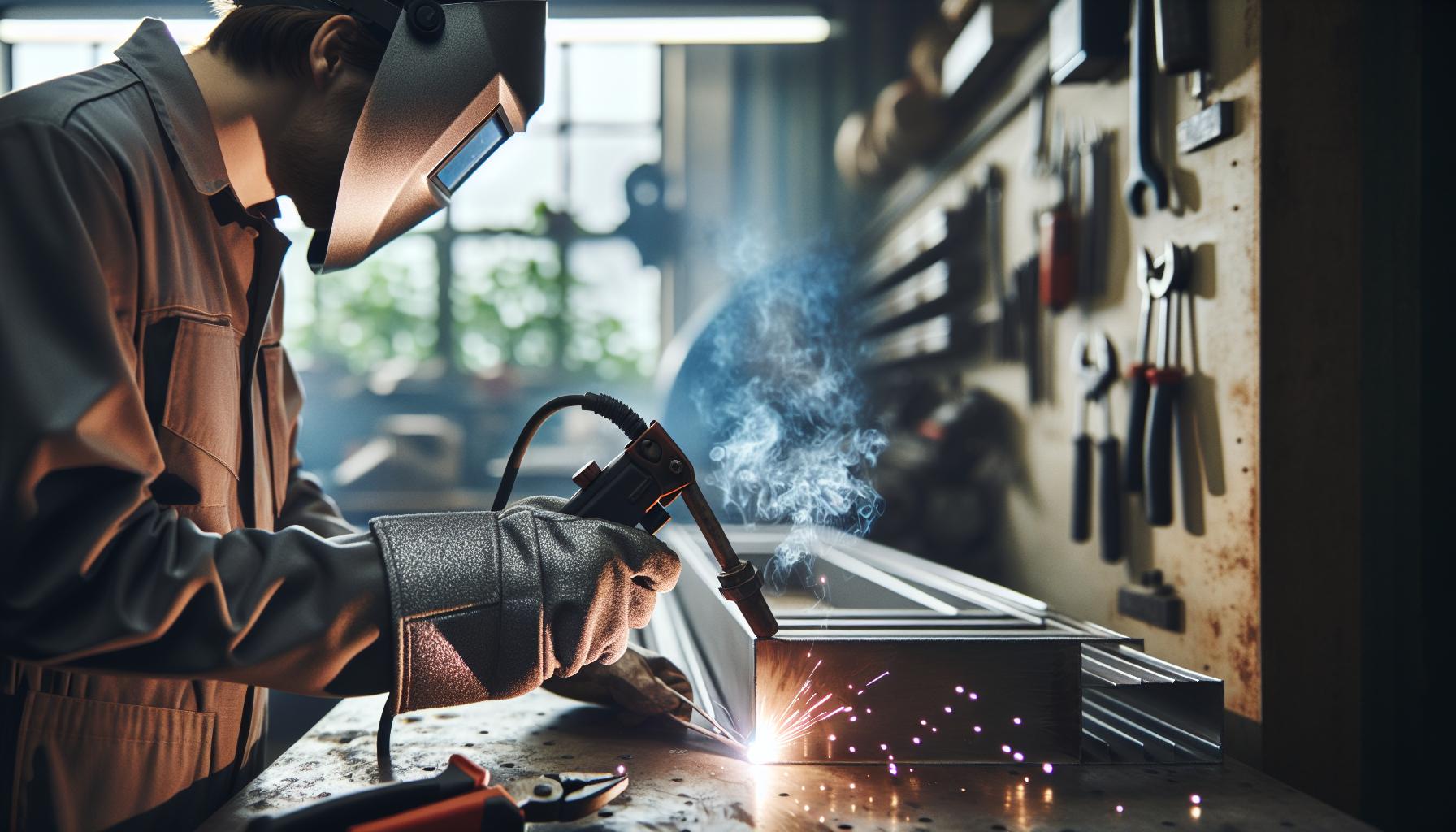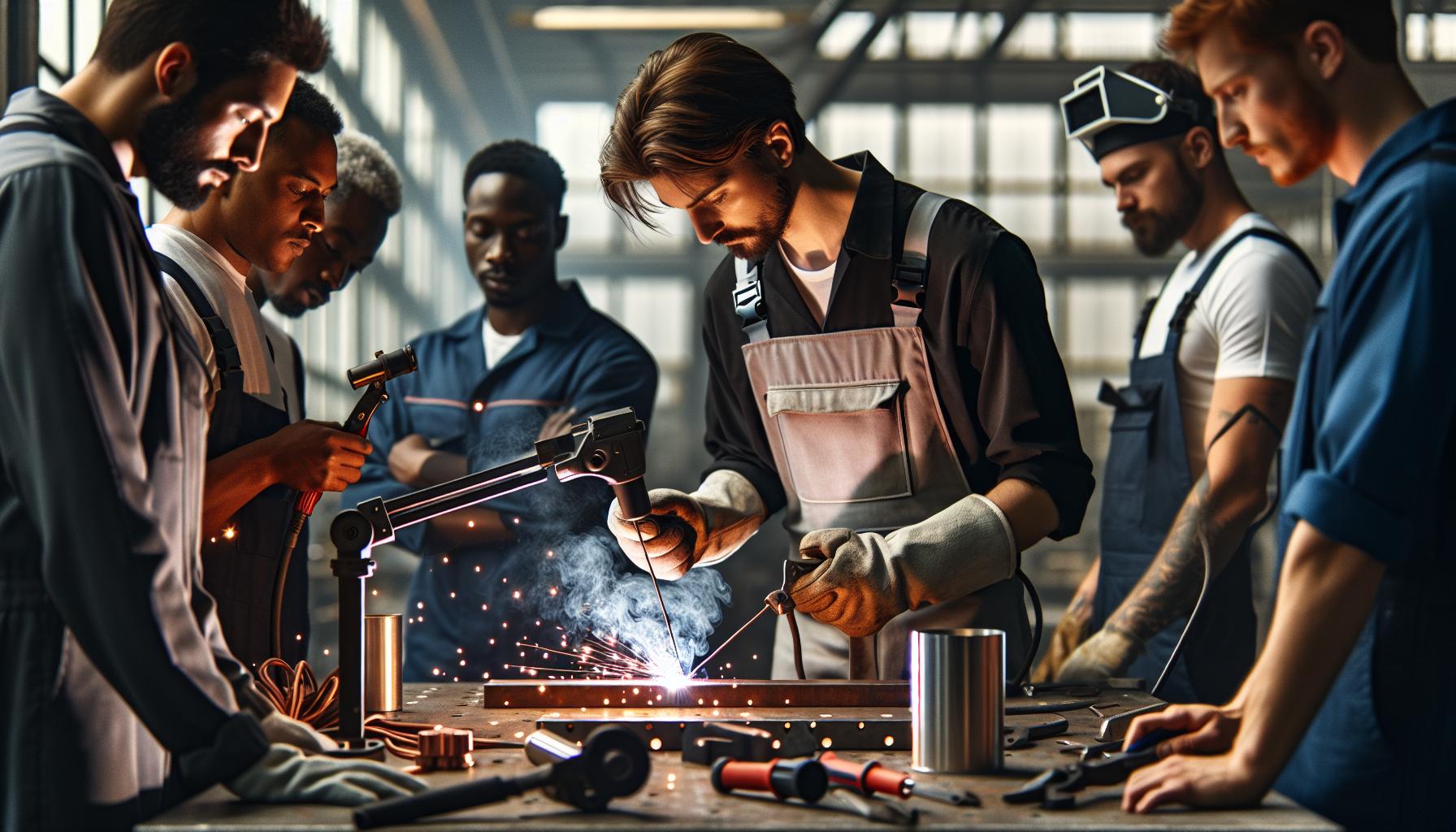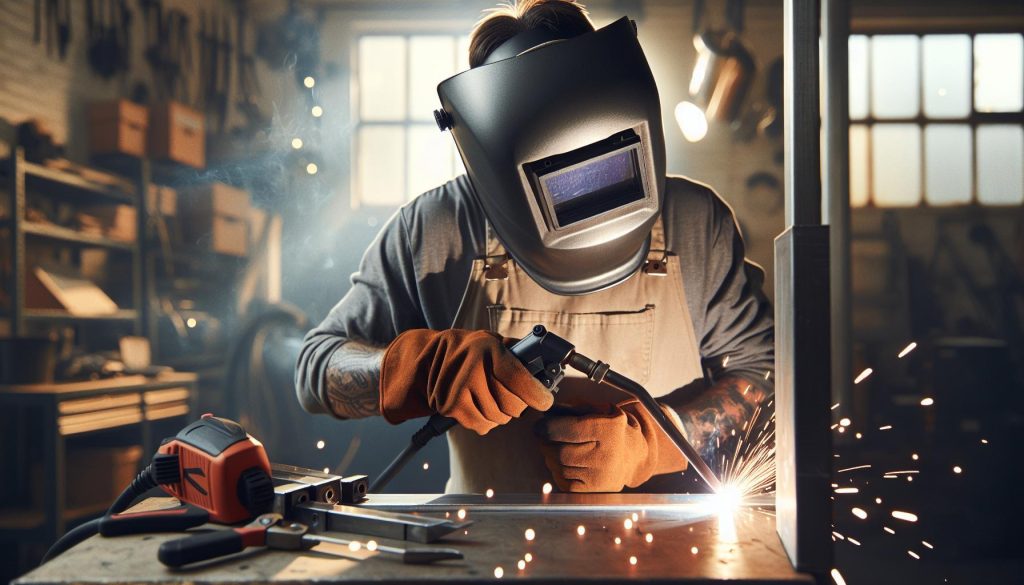Welding aluminum with a MIG welder is not just feasible; it opens doors to numerous creative and structural applications that metalworkers and DIY enthusiasts often seek. Many might assume that aluminum is exclusively the domain of TIG welding due to its unique challenges, but MIG welding can be a highly effective alternative when approached correctly. Understanding how to successfully weld aluminum using MIG techniques can significantly enhance your skill set and broaden your project possibilities. In this article, we will explore the essentials of MIG welding aluminum-from selecting the right equipment and settings to mastering techniques that ensure strong, clean welds. Whether you’re a novice aiming to expand your capabilities or an experienced welder looking for new methods, this guide promises valuable insights to elevate your welding projects. Ready to dive in? Let’s unlock the potential of MIG welding for aluminum together!
Can You Weld Aluminum with a MIG Welder? Exploring the Basics of MIG Welding Aluminum
Welding aluminum with a MIG welder is not only possible, but it’s also a popular choice for many fabricators due to its speed and flexibility. Unlike traditional welding methods, MIG (Metal Inert Gas) welding employs a continuously fed filler material, offering an efficient process suitable for various thicknesses of aluminum. This makes it particularly advantageous for projects that require quick turnarounds or large volumes of work, such as automotive and aerospace applications. Understanding the nuances of MIG welding aluminum can significantly enhance both the quality of your welds and your overall workflow.
One of the key factors to consider when MIG welding aluminum is the alloy type you are working with. Aluminum comes in various alloys, each having unique characteristics. For instance, 6061 aluminum is commonly used in structural applications due to its good mechanical properties and weldability. However, it may require specific settings for optimal welding. It’s crucial to ensure that your MIG welder is equipped with the right components, such as spool guns or push-pull systems, which can effectively feed aluminum wire without causing issues like bird-nesting or wire twisting.
When tackling aluminum welding projects, pre-cleaning the surface of the metal is essential. Aluminum oxidizes quickly, and the oxide layer can lead to poor welds if not removed properly. A clean, oxide-free surface facilitates better arc stability and penetration, resulting in stronger joints. Moreover, adjusting your welder settings-including voltage, wire feed speed, and the type of shielding gas (commonly a mix of argon and helium)-is vital. Experimenting with these variables can yield optimal results tailored to your specific aluminum alloy and project needs.
Lastly, while MIG welding aluminum can be forgiving, it is not devoid of challenges. Understanding common pitfalls-such as lack of penetration, excessive spatter, or burn-through due to the metal’s lower melting point-will prepare you for troubleshooting as you gain experience. With the right knowledge and equipment, welding aluminum can become a streamlined and rewarding task.
Understanding the Unique Challenges of Aluminum Welding
Welding aluminum presents a unique set of challenges that even experienced welders need to navigate carefully. One of the most significant obstacles is aluminum’s tendency to oxidize rapidly, forming a hard layer of aluminum oxide on its surface. This oxide layer can impede weld penetration and lead to weak joints if not adequately cleaned before welding. To achieve optimal results, it’s essential to either mechanically remove this oxide layer using a stainless steel brush or chemically treat it with appropriate descaling solutions to ensure a clean, conductive surface.
Another crucial factor to consider is the lower melting point of aluminum compared to steel. This characteristic means that welders must maintain careful control of their heat input. Too much heat can cause burn-through or warping, while too little can lead to inadequate fusion between the metal pieces. In addition, the thermal conductivity of aluminum requires higher travel speeds than steel, which can challenge the welder’s technique and rhythm. Adjustments to the MIG welding settings, such as voltage and wire feed speed, should be made accordingly to accommodate these differences.
MIG welding aluminum also requires special equipment to address these unique challenges effectively. Standard contact tips can wear out quickly due to aluminum’s sticky nature, and using a dedicated spool gun or push-pull system can significantly enhance the welding experience by preventing feed issues. Furthermore, selecting the appropriate shielding gas, typically a mix of argon and helium, can improve arc stability and reduce spatter-a common issue when welding aluminum.
Ultimately, while MIG welding aluminum offers many advantages in terms of speed and ease, mastering its nuances is essential for creating strong, aesthetically pleasing welds. Armed with the right knowledge and techniques, welders can overcome these challenges, making aluminum fabricating both efficient and successful.
Essential MIG Welder Equipment for Aluminum Projects
A successful aluminum MIG welding project hinges not only on skill but also on the right equipment. Unlike welding steel, aluminum requires specialized tools and components designed to handle its unique properties, such as a lower melting point and high thermal conductivity. Investing in the correct MIG welding equipment can make a marked difference in the quality and strength of your welds.
Essential Equipment for MIG Welding Aluminum
- MIG Welder with DC+ Output: Choose a MIG welder that can operate with direct current electrode positive (DCEP). This configuration helps to achieve better arc stability and penetration when welding aluminum.
- Spool Gun or Push-Pull System: Aluminum wire is softer and more prone to tangling than steel wire, often causing feed issues. A spool gun, which feeds the wire directly from a small spool, or a push-pull system, where the welder’s machine pushes the wire while a roller pulls it, is essential for smooth welding.
- Aluminum Wire: Select the proper welding wire, typically 4047 or 5356 aluminum alloy, depending on your specific project requirements. Ensure that the wire diameter matches your welder’s capabilities, often 0.030 to 0.045 inches for aluminum MIG welding.
- Shielding Gas: Use a gas mix of 100% argon or a blend of argon and helium. Helium can improve arc stability and penetration, especially when working with thicker materials, making it a frequent choice among professionals.
- Contact Tips and Nozzles: Employ copper or silver-plated contact tips specifically designed for aluminum. These materials reduce wear and help with better conductivity. Ensure the nozzle size accommodates your wire diameter to maintain proper gas coverage.
- Cleaning Tools: Prior to welding, it’s critical to remove the aluminum oxide layer. Invest in stainless steel brushes or chemical cleanings solutions, and sometimes use a dedicated cleaning tool designed for aluminum welding.
- Personal Protective Equipment (PPE): Safety should never be compromised. Use a welding helmet with appropriate shading, heat-resistant gloves, protective clothing, and respiratory protection if necessary.
Recognizing the importance of each component contributes significantly to the overall success of MIG welding aluminum. By ensuring that you have the right equipment tailored for aluminum, you can streamline the welding process, reduce defects, and achieve high-quality results. Mastering the use of these tools may seem daunting, but with practice and the right setup, even novice welders can create strong and beautiful welds in aluminum.
Step-by-Step Guide: How to MIG Weld Aluminum Successfully
Successfully welding aluminum with a MIG welder can elevate your projects to a professional level, improving strength and appearance. The unique characteristics of aluminum-such as its low melting point and high thermal conductivity-demand a methodical approach to ensure quality welds. Here’s how to achieve optimal results step-by-step.
Preparation is key. Start by ensuring your workspace is clean and free of contaminants. Use a stainless steel brush or a chemical cleaner to remove the aluminum oxide layer from the surface you plan to weld. This layer can inhibit proper fusion during the welding process. Once the surface is clean, set up your MIG welder with the required equipment: a spool gun or push-pull system, aluminum wire (either 4047 or 5356 alloy), and appropriate shielding gas (100% argon or a blend with helium for better penetration).
Next, adjust your welder settings. Begin by selecting the right voltage and wire feed speed to match the thickness of the aluminum you are working with. Typically, higher speeds and a hotter arc are needed for thicker materials. Conduct a test weld on scrap pieces to troubleshoot your settings and ensure the quality of the weld before moving on to your actual project.
As you begin welding, maintain a steady hand and consistent travel speed. Hold the gun at an angle of approximately 15 degrees from vertical and keep a distance of around 1/4 to 1/2 inch from the workpiece to maintain a stable arc. Be particularly mindful of overheating, which can lead to burn-throughs. Allow the metal to cool slightly between passes if necessary.
Once the welding is complete, let the weld metal cool down naturally before proceeding to any post-weld treatment. This helps to minimize the risk of cracking and distortion. Depending on your project, you may want to grind or polish the welds to achieve a smooth finish-or apply an appropriate anodizing treatment to enhance corrosion resistance.
Following these steps closely will ensure successful MIG welding of aluminum, enabling both novices and experienced welders to produce high-quality, resilient welds with precision and confidence.
Choosing the Right Filler Rods for Aluminum Welding
Choosing the appropriate filler rod is crucial for successful aluminum welding, as it directly impacts the strength, appearance, and integrity of the weld. When welding aluminum with a MIG welder, the two most commonly used filler rods are the 4047 and the 5356 alloys. Each type has specific characteristics that make it suitable for different applications, thereby influencing the quality of the weld.
The 4047 filler rod, which comprises about 12% silicon, is ideal for applications where improved fluidity and reduced weld cracking are desired. This alloy is particularly beneficial for welding thin materials and can create smoother and more aesthetically pleasing welds due to its low melting point. It is often used for automotive repair and decorative pieces. On the other hand, the 5356 filler rod, containing about 5% magnesium, is more robust, making it suitable for applications requiring higher strength, such as structural parts in marine environments. This filler alloy exhibits excellent corrosion resistance, essential for welding aluminum used in saltwater conditions.
When selecting a filler rod, consider the following factors:
- Materials: Match the filler rod alloy to the base aluminum alloy being welded for optimal compatibility and strength.
- Joint Design: Different joint designs may benefit from specific filler materials; for example, butt joints may require a stronger rod like 5356.
- Welding Position: The fluidity of the molten weld pool can vary with different filler rods. 4047 is often favored in vertical positions, while 5356 is more versatile across various positions.
- Final Use: For components exposed to stress or requiring higher durability, choose a rod that enhances mechanical properties.
Being knowledgeable about these options ensures you select the most effective filler for your specific aluminum welding project, leading to stronger and more reliable results. Always consult the technical data sheets for each filler rod before finalizing your choice, as they provide essential information on compatibility and performance.
MIG Welding Settings: Optimizing Your Settings for Aluminum
When it comes to achieving high-quality aluminum welds, the correct MIG welding settings are pivotal. Aluminum requires distinct settings compared to other metals due to its unique properties. Unlike steel, aluminum conducts heat rapidly, meaning that the right balance of voltage and wire feed speed is essential to prevent burn-through while ensuring good penetration.
To optimize your MIG welder settings for aluminum, first consider the wire diameter. A common choice is 0.035-inch (0.9 mm) wire for general projects, while a larger 0.045-inch (1.2 mm) wire can be used for thicker materials or high-speed applications. The voltage settings typically range from 16 to 20 volts, but adjustments may be required based on the material thickness and type of filler wire used. Start at a lower voltage and gradually increase it until the desired arc stability and bead appearance are achieved.
When adjusting wire feed speed, a common practice is to set it between 160-300 inches per minute (IPM) for aluminum. Too fast a feed can cause inconsistent arc stability, resulting in poor penetration and weak welds, while too slow a feed could lead to overheating. The travel speed also plays a crucial role; a faster travel speed can help mitigate heat buildup, while a slower speed allows for better penetration.
In addition to the basic settings, current type matters. While many welders run on DC (direct current), switching to AC (alternating current) is advisable for aluminum welding. AC provides better cleaning action on aluminum oxide and results in a smoother and more penetrative weld. Another setting worth considering is the inductance, which controls the softness of the arc. A higher inductance can help stabilize the arc and reduce spatter, especially valuable when working on thin sheets.
Creating a Welding Parameter Chart can be beneficial as well. Include variables like wire size, voltage, wire feed speed, and travel speed for different aluminum thicknesses. This chart allows for quick reference and adjustments, ensuring optimal settings for various projects.
Finally, don’t overlook the importance of test welding. Running a few test beads on scrap aluminum can help fine-tune the settings before tackling your main project, allowing for adjustments based on visual feedback. Observing the bead characteristics such as width and height provides critical feedback on penetration and fusion with the base material, guiding further adjustments to achieve that perfect weld.
Common Mistakes in Aluminum MIG Welding and How to Avoid Them
Welding aluminum with a MIG welder can be a rewarding yet challenging process, especially for those who are not well-acquainted with the nuances of this lightweight metal. One of the most common mistakes is underestimating the significance of clean surfaces. Aluminum oxide can form a tough layer that prevents effective fusion, leading to weak or porous welds. It is essential to thoroughly clean the joint area using a stainless steel brush or a chemical solvent designed for aluminum before starting any welding. Remember, cleanliness not only enhances the quality of the weld but also minimizes defects that can occur during the process.
Another frequent issue is incorrect settings on the MIG welder. Many novice welders stick with default settings without adjustments tailored for aluminum, which requires unique voltage and wire feed speed configurations. For example, starting with too high of a voltage can lead to burn-through, while too low can cause weak penetration. Conducting tests on scrap material to dial in the appropriate settings for voltage, travel speed, and feed rate can greatly improve the outcome of aluminum welds.
In addition, using the wrong filler material is a pitfall that can compromise the integrity of the weld. For aluminum, it’s crucial to choose the right filler rod that matches the base material’s alloy. Using incorrect filler materials can lead to incompatibility, which affects the strength and conductivity of the joint. It’s advisable to consult alloy guides and select filler rods based on the specific type of aluminum you’re working with.
Finally, neglecting safety protocols is a significant mistake that can lead to serious injuries. Proper safety gear, including gloves, goggles, and appropriate clothing, is imperative when welding. Additionally, ensure that your working area is well-ventilated to prevent harmful fumes from accumulating. By addressing these common pitfalls, welders at all skill levels can significantly improve their aluminum welding projects, leading to stronger, cleaner, and safer results.
Safety Protocols for Welding Aluminum with a MIG Welder
Welding aluminum using a MIG welder presents unique challenges that necessitate strict adherence to safety protocols to ensure both the welder’s protection and the quality of the finished product. Aluminum can emit harmful fumes when heated, and without proper ventilation and protective gear, welders may expose themselves to health hazards. To mitigate risks associated with aluminum welding, it’s critical to create a safe working environment.
- Personal Protective Equipment (PPE): Always wear appropriate PPE, including welding gloves that are heat-resistant, a durable welding helmet with UV and IR protection, and flame-retardant clothing. Safety glasses should be worn under the helmet for additional protection against debris.
- Ventilation: Ensure that your workspace is well-ventilated. Welding aluminum can produce harmful fumes and gases that can lead to respiratory issues. Using local exhaust ventilation or working outdoors can significantly reduce exposure to these hazards.
- Fire Safety: Be aware of fire hazards when welding. Aluminum can ignite combustible materials that may be nearby. Keep a fire extinguisher rated for metal fires on hand, and clear the area of any flammable substances before you begin welding.
- Proper Setup: Make sure your MIG welder is set up correctly before welding. Check for any electrical hazards, and ensure that all cables and hoses are in good condition to prevent sparks or electrocution.
Maintaining a clean workstation is just as important. Ensure that surfaces are free from oils, greases, and other contaminants that could ignite during the welding process. This not only contributes to a safer workspace but also aids in achieving cleaner welds by preventing contamination of the weld pool.
Lastly, continually educating yourself about welding safety standards and best practices can further enhance safety. Many organizations offer resources and training courses to improve awareness and skills in safe weld practices. Incorporating these safety protocols into your aluminum welding process is not just a regulatory requirement; it is also a commitment to professional integrity and craftsmanship.
Comparative Techniques: MIG vs. TIG Welding for Aluminum
Aluminum welding presents unique challenges that often require a careful choice between different welding techniques. MIG (Metal Inert Gas) and TIG (Tungsten Inert Gas) welding are two popular methods, each with distinct advantages and nuances that make them suitable for various applications. Understanding these differences can help welders decide which technique best meets their project requirements.
MIG welding, known for its speed and ease of use, is ideal for thicker aluminum materials. It employs a continuous wire feed for the electrode, making it efficient for large projects that demand high production rates. This method allows for easier manipulation of the welding arc, resulting in a more consistent bead. Moreover, MIG welding typically requires less skill to operate compared to TIG, making it a popular choice among beginners and in industries demanding rapid repair work. However, MIG may not provide the precision required for delicate applications or intricate designs, often producing wider weld beads that may necessitate additional finishing work on thinner materials.
In contrast, TIG welding offers enhanced control and precision, making it suitable for thinner aluminum sections and detailed work, such as aerospace applications or artistic projects. This method uses a non-consumable tungsten electrode, allowing for accurate adjustments of the weld pool temperature, which is critical for preventing warping and ensuring the integrity of lighter materials. TIG’s versatility also allows for the use of filler rods, enabling welders to tailor the weld characteristics specifically to the alloy being used. While TIG welding can be slower and requires a higher level of skill, the results are often superior in terms of weld quality and aesthetics.
Choosing between MIG and TIG for aluminum welding ultimately depends on the specific project demands, material thickness, and desired finish. For those looking for efficiency and speed in welding thicker sections, MIG may be the preferable option. Conversely, for detailed work where the highest quality and precision are non-negotiable, TIG shines, albeit at a slower pace. Understanding these comparative techniques allows welders to select the appropriate method for their specific applications, ensuring both quality and efficiency in their aluminum welding projects.
Post-Weld Treatment and Finishing for Aluminum Welds
Welding aluminum, particularly with MIG techniques, can yield visually stunning and structurally sound results, but the work doesn’t end once the welding is complete. Effective post-weld treatment and finishing are crucial for enhancing the integrity and appearance of the welds. Aluminum welding often necessitates additional steps due to its unique properties, including susceptibility to corrosion and the formation of an oxide layer. Addressing these challenges not only improves aesthetics but also prolongs the lifespan of the welded assembly.
One of the first steps post-welding involves removing the oxide layer that forms on aluminum. This can be achieved through mechanical methods such as sanding or grinding, or through chemical processes using specialized cleaners. Ensuring a clean surface is imperative, as contaminants can hinder further treatments like anodizing or painting. For projects where appearance is paramount, a process such as media blasting may be employed to create a uniform surface finish before any additional coatings are applied.
After surface preparation, many fabricators opt for anodizing, which increases corrosion resistance while also providing a range of aesthetic options, from clear to colored finishes. Anodizing not only thickens the natural oxide layer but also allows for dye penetration, enhancing the color depth. If painting is desired instead, proper priming is vital; specific primers designed for aluminum can ensure better adhesion and performance of the paint. Additionally, it’s recommended to use epoxy-based primers for maximal durability against environmental elements.
To avoid common pitfalls post-weld, it’s essential to inspect the welded joints visually and, if necessary, conduct non-destructive testing. This could include methods such as dye penetrant testing or ultrasonic testing to detect potential defects within the weld. Finally, maintaining proper documentation of the post-weld treatment processes can benefit future reference and quality assurance. These diligent steps in post-weld treatment not only refine the final product but also enhance its durability and overall performance in real-world applications.
Real-World Applications of MIG Welding Aluminum in Various Industries
MIG welding aluminum has found a place in various industries due to its effectiveness, speed, and versatility. From transportation to construction, the ability to fuse aluminum components has transformed how these sectors operate, creating lightweight yet robust products that withstand the test of time. For instance, in the automotive industry, MIG welding is instrumental in producing lightweight frames and body panels, enhancing fuel efficiency without sacrificing safety or durability. The ease of alignment and the clean finish provided by MIG welding make it ideal for automotive applications where aesthetics are significant.
In the aerospace industry, the stringent requirements for weight and strength make aluminum a preferred material for components such as aircraft skins and frames. Here, MIG welding allows for the systematic bonding of parts that meet rigorous safety standards while minimizing overall weight. Additionally, innovative designs in the aerospace sector benefit from the flexibility and speed of MIG welding, allowing manufacturers to adapt quickly to new challenges and technologies.
Applications in Manufacturing and Construction
Aluminum’s lightweight characteristics also extend to the construction industry, where it is commonly used in frameworks for buildings, bridges, and infrastructure projects. MIG welding facilitates the rapid construction of structures while ensuring high-quality joints that can withstand environmental stress. The ability to easily manipulate aluminum makes it a top choice for architects and contractors looking to push design boundaries. Moreover, prefabricated aluminum sections that are welded together on-site illustrate another application, allowing for quicker assembly times and reduced labor costs.
Additionally, the maritime industry takes advantage of MIG welding aluminum for boat hulls and other structures. Aluminum’s resistance to corrosion, combined with the efficiency of MIG welding, results in robust ships capable of enduring harsh marine conditions. The production of yachts and commercial vessels similarly relies on MIG welding for both performance and visual appeal, ensuring that both functionality and aesthetics meet customer expectations.
- Transportation: Automotive frames and panels, reducing vehicle weight for better fuel economy.
- Aerospace: Precise welding of aircraft components critical for safety and weight reduction.
- Construction: Fast assembly of lightweight structural components for buildings and bridges.
- Maritime: Production of durable boat hulls that resist corrosion and harsh conditions.
The adaptability of MIG welding aluminum across these industries highlights its significance. By optimizing the strengths of aluminum while ensuring high-quality welds, industries are empowered to innovate and meet modern demands effectively.
Frequently asked questions
Q: Can MIG welding be used effectively on aluminum?
A: Yes, MIG welding is suitable for aluminum due to its ability to create strong welds with the right setup. Using suitable shielding gas, such as argon, and proper settings will yield optimal results. Consult the section on “MIG Welding Settings: Optimizing Your Settings for Aluminum” for specific guidelines.
Q: What filler rod should I use for MIG welding aluminum?
A: For MIG welding aluminum, 4047 or 4045 filler rods are common choices because of their compatibility with most aluminum alloys. They enhance strength and improve the quality of the weld. Refer to “Choosing the Right Filler Rods for Aluminum Welding” for more detailed advice.
Q: What type of shielding gas is best for MIG welding aluminum?
A: Argon is the preferred shielding gas for MIG welding aluminum as it provides excellent arc stability and protects the weld from contamination. Ensure to review the “Essential MIG Welder Equipment for Aluminum Projects” section for more insights on equipment.
Q: What settings are necessary for MIG welding aluminum?
A: To weld aluminum using a MIG welder, set a higher voltage and fast travel speed to manage the unique heat conductivity of aluminum. Refer to “MIG Welding Settings: Optimizing Your Settings for Aluminum” for comprehensive setting recommendations.
Q: How can I prevent common mistakes when MIG welding aluminum?
A: To avoid mistakes like burn-through or poor fusion, ensure proper cleaning of the aluminum surface before welding, and adjust heat settings according to material thickness. Check the “Common Mistakes in Aluminum MIG Welding and How to Avoid Them” section for detailed strategies.
Q: Is MIG welding aluminum more difficult than welding steel?
A: MIG welding aluminum can be more challenging than steel due to its higher thermal conductivity and susceptibility to distortion. However, with the right technique and understanding of the material, successful aluminum welds are achievable. Explore the “Understanding the Unique Challenges of Aluminum Welding” section for further information.
Q: What should I do post-weld to finish an aluminum joint?
A: After MIG welding aluminum, it’s essential to perform proper cleaning, such as removing slag and any oxidation. Additionally, consider applying a protective coating to prevent corrosion. For further details, see the “Post-Weld Treatment and Finishing for Aluminum Welds” section of the article.
Q: Can I weld different aluminum alloys together with a MIG welder?
A: Yes, welding different aluminum alloys is possible, but one alloy should ideally be predominant. Using compatible filler metals will ensure a strong joint. More information can be found in the sections discussing “Choosing the Right Filler Rods for Aluminum Welding” and “Common Mistakes in Aluminum MIG Welding and How to Avoid Them.”
Future Outlook
Unlock the potential of your MIG welder by diving into aluminum projects-it’s possible, and now you know how! With the right techniques and settings, you can achieve clean, strong welds that elevate your craftsmanship. If you’re eager to expand your skills further, check out our guides on advanced MIG welding techniques and safety protocols to ensure your workspace remains secure.
Don’t wait-take the next step in your welding journey today! Sign up for our newsletter to stay updated on the latest tips, tools, and resources tailored for both beginners and seasoned welders. Have questions or tips of your own? Join the conversation in the comments below! Remember, mastering MIG welding on aluminum opens doors to exciting projects and career opportunities in the welding industry. Explore our other resources to unlock your full potential and keep improving your craft!












